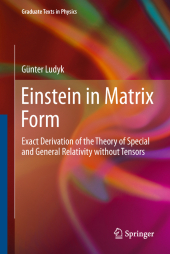 Neuerscheinungen 2015Stand: 2020-02-01 |
Schnellsuche
ISBN/Stichwort/Autor
|
Herderstraße 10
10625 Berlin
Tel.: 030 315 714 16
Fax 030 315 714 14
info@buchspektrum.de |

Günter Ludyk
Einstein in Matrix Form
Exact Derivation of the Theory of Special and General Relativity without Tensors
2015. xiv, 194 S. 11 SW-Abb.,. 235 mm
Verlag/Jahr: SPRINGER, BERLIN 2015
ISBN: 3-642-43906-3 (3642439063)
Neue ISBN: 978-3-642-43906-3 (9783642439063)
Preis und Lieferzeit: Bitte klicken
This book derives the fundamental equations of Einstein´s theory of special and general relativity using matrix calculus, without the help of tensors. It provides the necessary mathematical tools in a user-friendly way.
This book is an introduction to the theories of Special and General Relativity. The target audience are physicists, engineers and applied scientists who are looking for an understandable introduction to the topic - without too much new mathematics. The fundamental equations of Einstein´s theory of Special and General Relativity are derived using matrix calculus, without the help of tensors. This feature makes the book special and a valuable tool for scientists and engineers with no experience in the field of tensor calculus. In part I the foundations of Special Relativity are developed, part II describes the structure and principle of General Relativity. Part III explains the Schwarzschild solution of spherical body gravity and examines the "Black Hole" phenomenon. Any necessary mathematical tools are user friendly provided, either directly in the text or in the appendices.
Special Relativity.- The Galilei Transformation.- The Lorentz Transformation.- The Invariance of Quadratic Forms.- Velocity Addition.- Lorentz Transformation of Velocities.- Lorentz Transformation of Impulses.- Acceleration and Force.- Relativistic Electrodynamics.- Energy Momentum Matrix.- General Relativity.- General Relativity and Riemannian Geometry.- Some Mathematics: Derivation of a function, vector, and matrix with respect to time.- Motion in a Gravity Field.- Geodesic Path.- Exampel: Rotating System.- General Transformations of Coordinates.- Some Differential Geometry.- Parallel Displacement.- Riemannian Curvature Matrix.- Properties of the Riemannian Curvature Matrix.- The Ricci Matrix and its Properties.- General Theory of Gravitation.- Summary.- Hilbert Functional.- Gravitation of a Spherical Body.- Schwarzschild Solution.- The Influence of a Body upon its Vicinity.- The Interior Schwarzschild Solution.- Black Holes.- Rotating Masses.
From the book reviews:
Addressing physicists, applied scientists and engineers with no previous knowledge of tensor calculus, Ludyk presents in a well-written manner a rather easy introduction to special as well as general relativity by solely using matrix calculus and elementary differential geometry. It is more than certain that Ludyk s treatment will make it possible for a larger number of students to get acquainted with special and general relativity theory at an introductory, undergraduate level. (Theophanes Grammenos, Mathematical Reviews, April, 2014)
The main audience for this book can be those who have experience with practical calculations by use of matrices and vectors, but who have not the time to become familiar with tensor calculus. this book presents essentially all ingredients what one expects from a book aimed to introduce special and general relativity . (Hans-Jürgen Schmidt, zbMATH, Vol. 1272, 2013)
After receiving his PhD in 1967, Günter Ludyk habilitated and has been appointed "Scientific Advisor and Professor" (associate professor) of the Technical University of Berlin in 1970. In 1971 he has been a visiting professor at the Technical University of Graz/Austrial. Since 1972 he is a Full Professor at the Physics/Electrical Engineering Faculty of the University of Bremen. His area of research includes the theory of dynamical systems and the application of interval mathematics to generate high-precision results. He published various books on these topics both in German and English, e. g. "Time-Variant Discrete-Time-Systems" in 1981 and "Stability of Time-Variant Discrete-Time Systems" in 1985.


